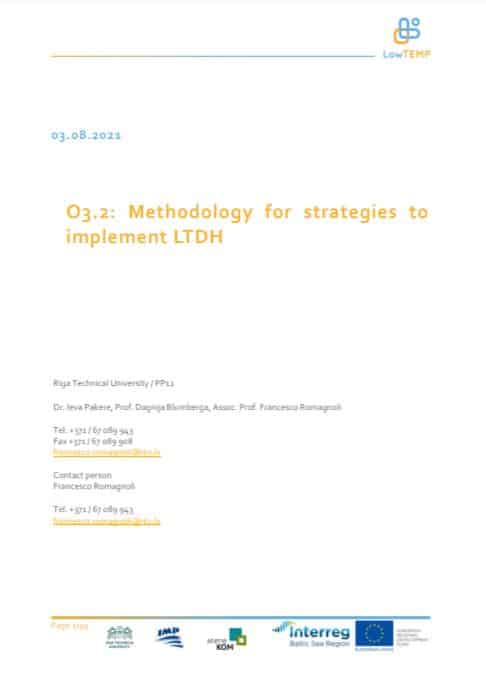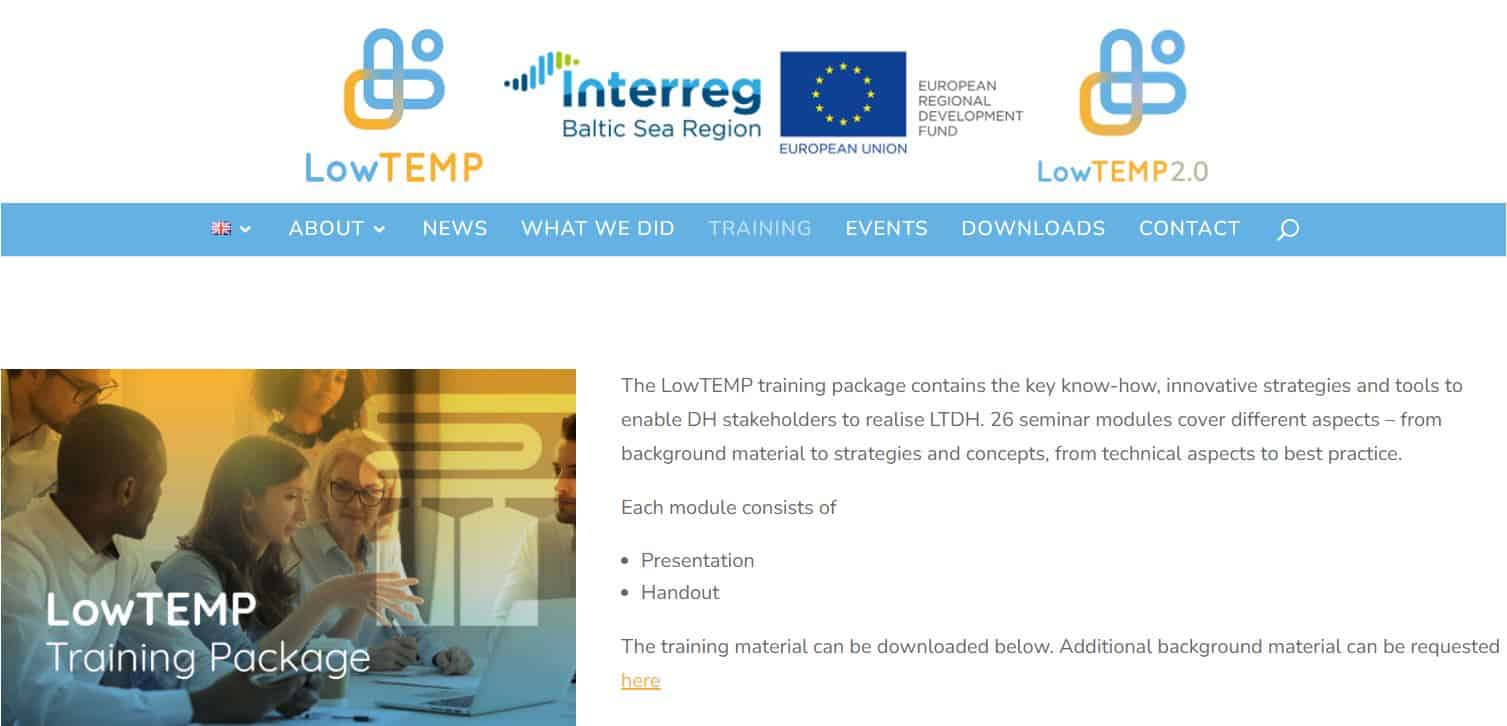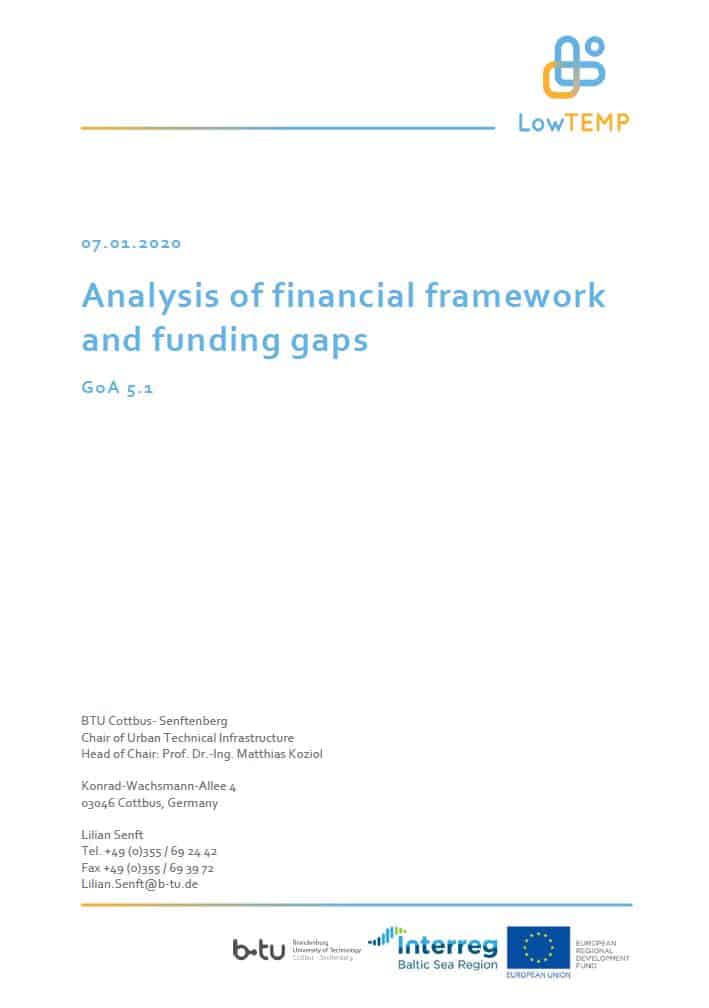LowTEMP
Modernisation of district heating systems (DHS) is in full swing in the Baltic Sea region, but more needs to be done. The potential in using low temperature district heating systems with a significant decrease in heat loss by using renewable energy and waste as heat sources is not fully unveiled. District heating systems are somehow widesread in the Baltic Sea region, but the current generation of heating grids and technologies is outdated. Furthermore, they often do not comply with latest energy efficiency standards, both in renovated or newly constructed buildings. This leads to pressing challenges such as heat energy losses, hydraulic problems and economic disadvantages.
Need for an upgrade
Therefore district heating systems and technologies need to be adapted and upgraded in order to decrease grid heat losses and exploit synergies. The optimisation of district heating grids can be done using low temperature heat distribution. This means that supply and return temperatures should be as low as possible.
The installation of low temperature grids or its integration into existing district heating systems is a challenge, in particular for economic and technical planning: investments require high upfront costs, while construction works on the pipeline system require the coordination of experts and public authorities.
Budgets
in numbers
-
3.77MillionTotal
-
2.84MillionErdf
-
0.17MillionEni + Russia
-
0.00MillionNorway
Achievements
19 partners from nine countries and 30 associated organisations gathered together in order to provide district heating stakeholders with know-how and strategic tools on planning, financing, installing and managing Low Temperature District Heating systems (LTDH). The project involved municipal, regional and national authorities, DH suppliers, energy agencies, associations, business support organisations, as well as research institutions.
Boosting implementation with new methodology and training
LowTEMP developed a methodology for strategies to increase energy efficiency in existing and new district heating networks. The methodology provides specific step-by-step guideline on how to develop energy strategy and apply it at municipal level. It contains area analysis, stocks evaluations, analysis of increasing energy efficiency potential, technical preconditions and requirements of district heating, profitability assessment, CO2 balance and monitoring methods.
With 26 modules containing information on strategies and concepts to the best practices, the project provided valuable training material as a basis for training on different possibilities of heating supply, technical and financing issues, as well as corporate development of energy strategies and business models.
Local pilots inspire
The tailored solutions based on the current type of the district heating supply infrastructures, the existing problems and potential for improvement were tested in pilots across the Baltic Sea region. For instance, in Aluksne (Latvia) energy efficiency measures were introduced in a kindergarten in order to prepare for future LTDH system. In Holbaek (Denmark) the pilot implemented a LTDH subnet in a conventional DH network; in Halmstad (Sweden) a low-temperature district heating grid was installed in a completely new residential area; in Gulbene (Latvia) an existing heating network was converted to a low temperature concept, with low temperature heating system, with more efficient wood pellet boiler house and newly constructed heat pipes being provided to some municipal buildings. More about the pilot measures can be found here.
Improved calculations on economic efficiency and business modelling
LowTEMP developed a calculation method, which helps understand the profitability and funding gap of a given district heating project. It is based on the evaluation of the internal rate of return and net present value of an investment over a period of 20 years. It includes an excel based calculation tool, a manual and an analysis for more background information on financial framework and funding gaps. The tool allows to calculate investments for grid and/or generating plants.
Additionally, publishing the Study on Business Models and Innovative Funding Structures the project presented a business model on tools based on low temperature district heating. It provides examples of innovative pricing models, new value chains, business opportunities, as well as innovative funding structures. A toolbox and a template of a business model canvas complement the study. The material is developed for district heating companies and municipalities, who want to examine new business opportunities and understand how they could change their business model and funding structure for district heating in a low temperature district heating scenario.
The project wanted not only to prove that district heating upgrades are a necessity to counteract the inefficiency of outdated systems, but also that upgrades are financially profitable for end-users and operators. So further initiatives and investments in smart and sustainable district heating systems should be triggered. LowTemp tools help exactly in this, as they are ready-for-use means to take steps towards improving district heating systems. This is a way on which the pilot municipalities already made steps forward.
The Interreg project LowTEMP used EUR 3.45 million from the European Union to enable the implementation of low temperature district heating. Besides the introduction of new technical and financial strategies, the project has additionally succeeded in strengthening cooperation with H2020 project Cool DH, Halmstad University, HafenCity University, Euroheat & Power which paved the way for new collaborations in district heating.
Outputs
Methodology for strategies to implement Low Temperature District Heating (LTDH)

Training toolkit

Calculation method on economic efficiency and funding gaps

Business models and innovative funding structures

Project Stories
-
29.03.2021
Cooperation as the key to a climate-neutral Baltic Sea region
A common challenge for the countries in the Baltic Sea region is how to produce green and climate-neutral energy. In fact, as much as 75% of the EU greenhouse gas emissions still come from energy use and production. Cooperation and sharing good practices in Interreg projects, such as LowTEMP, Baltic Integrid and Area 21, can be a game-changer in accelerating the energy transition in the region.Read full story -
11.06.2018
Rethinking energy in the Baltic Sea region
Establishing more sustainable and competitive energy systems that have a less harmful impact on the environment are among the core challenges for the Baltic Sea region. Two Interreg projects, AREA 21 and LowTEMP, unlock energy efficiency potential by triggering public and private strategic partnerships for energy production and management and by offering low temperature district heating technology for more efficient heating systems.Read full story
Partners
Institute of Fluid Flow Machinery, Polish Academy of Sciences (IMP PAN)
- TownGdańsk
- RegionTrójmiejski
- CountryPoland
- RepresentativeAdam Cenian
- Phone
- E-Mail
- Web
Brandenburg University of Technology (BTU) Cottbus - Senftenberg
- TownCottbus
- RegionCottbus, Kreisfreie Stadt
- CountryGermany
- RepresentativeLilian Senft
- Phone
- E-Mail
- Web
ZEBAU - Centre for Energy, Construction, Architecture and the Environment GmbH
- TownHamburg
- RegionHamburg
- CountryGermany
- RepresentativeJan Gerbitz
- Phone
- E-Mail
- Web
Holbaek Municipality
- TownHolbaek
- RegionVest- og Sydsjælland
- CountryDenmark
- RepresentativeJørgen Grubbe
- Phone
- E-Mail
- Web
Gate 21
- TownAlbertslund
- RegionKøbenhavns omegn
- CountryDenmark
- RepresentativeAnders Hasselager
- Phone
- E-Mail
- Web
Sustainable Business Hub (SBHub)
- TownMalmö
- RegionSkåne län
- CountrySweden
- RepresentativeCecilia Thapper
- Phone
- E-Mail
- Web
Thermopolis Ltd.
- TownLapua
- RegionEtelä-Pohjanmaa
- CountryFinland
- RepresentativeLea Hämäläinen
- Phone
- E-Mail
- Web
District Heating Kurikka
- TownKurikka
- RegionEtelä-Pohjanmaa
- CountryFinland
- RepresentativePetri Viinikainen
- Phone
- E-Mail
- Web
Tartu Regional Energy Agency (TREA)
- TownTartu
- RegionLõuna-Eesti
- CountryEstonia
- RepresentativeKalle Virkus
- Phone
- E-Mail
- Web
Riga Technical University (RTU)
- TownRiga
- RegionRīga
- CountryLatvia
- RepresentativeFrancesco Romagnoli
- Phone
- E-Mail
- Web
Vidzeme Planning Region
- TownCesis
- RegionVidzeme
- CountryLatvia
- RepresentativeLīga Puriņa-Purīte
- Phone
- E-Mail
- Web
Gulbene Municipality Council
- TownGulbene
- RegionVidzeme
- CountryLatvia
- RepresentativeBaiba Kalmane
- Phone
- E-Mail
- Web
Klaipeda University
- TownKlaipeda
- RegionKlaipėdos apskritis
- CountryLithuania
- RepresentativeArunas Andziulis
- Phone
- E-Mail
- Web
Public Institution Housing Energy Efficiency Agency
- TownVilnius
- RegionVilniaus apskritis
- CountryLithuania
- RepresentativeSimona Ramanauskienė
- Phone
- E-Mail
- Web
ANO Energy Efficiency Centre (ANO EEC)
- TownPetrozavodsk
- RegionArkhangelsk Oblast
- Country
- RepresentativeAlexander Berdino
- Phone
- E-Mail
- Web
District Heating Enterprise Ltd. - OPEC Gdynia
- TownGdynia
- RegionTrójmiejski
- CountryPoland
- RepresentativeJoanna Kotowicz
- Phone
- E-Mail
- Web
AGFW-Project-GmbH
- TownFrankfurt am Main
- RegionFrankfurt am Main, Kreisfreie Stadt
- CountryGermany
- RepresentativeGeorg Bosak
- Phone
- E-Mail
- Web
Kalundborg Municipality
- TownKalundborg
- RegionVest- og Sydsjælland
- CountryDenmark
- RepresentativeJohan Ib Hansen
- Phone
- E-Mail
- Web
Halmstad Energy and Environment (HEM)
- TownHalmstad
- RegionHallands län
- CountrySweden
- RepresentativeRolf Strandell
- Phone
- E-Mail
- Web
-
Project managerBritta Schmigotzkiatene KOM GmbH
-
Legal representativeMarcin LackowskiInstitute of Fluid Flow Machinery, Polish Academy of Sciences (IMP PAN)
-
Financial managerChristoph Waldatene KOM GmbH
-
Communication managerMagdalena Jähleratene KOM GmbH



